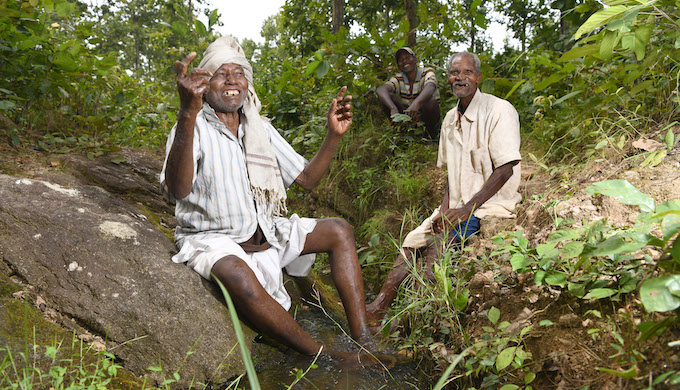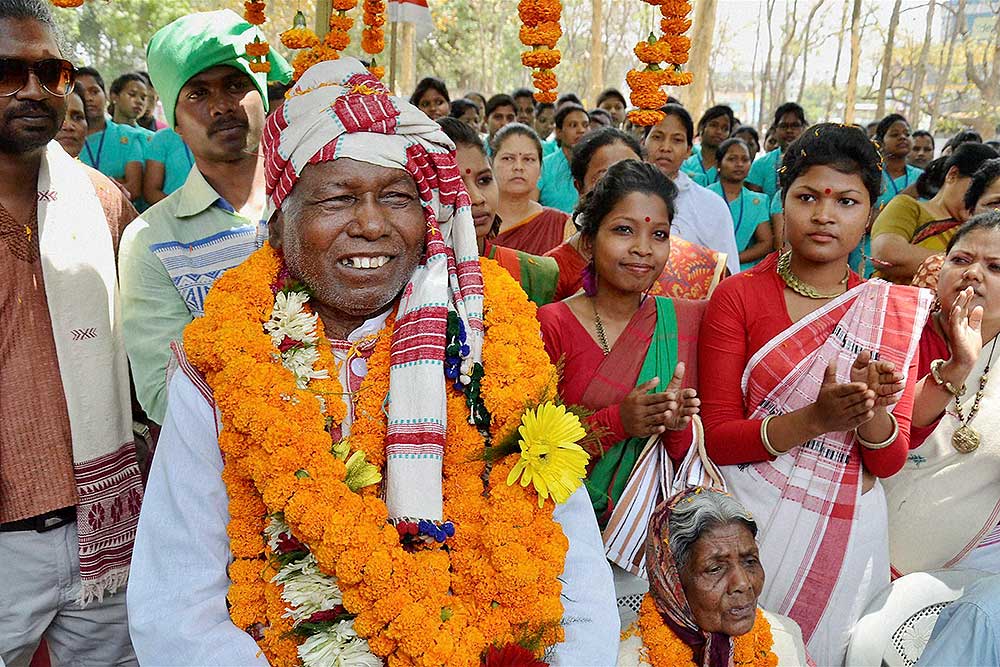“I don’t know who has published these books. This biography of mine has been published by an agricultural magazine and is also in the newspaper.”
“What’s written in it?”
“I don’t have any idea. I can’t read.”
There are those who claim to be climate warriors while generating humongous amounts of carbon footprints. There are others whose every step genuinely inches towards conserving the environment. Simon Oraon, affectionately called Simon Baba, belongs to the latter.

Awarded the Padma Shri in 2016, Simon Oraon, from the tribal Oraon community, has been persistently working on water management and forest protection from his nascent years. National award-winning filmmaker Biju Toppo’s documentary ‘Jharia‘ journeys with Simon Oraon as he narrates his ordeals and achievements alike.
the tribal communities of Jharkhand have hitherto existed in consonance with nature for thousands of years. It is their love for the environment, their intelligence in pursuing their existence, and their democratic self-governance that have made them survive sustainably with nature
Native to Ranchi, Jharkhand, Biju Toppo establishes an intimate association between nature and the indigenous communities of Jharkhand in the film. Every frame characterises them not as separate entities but as closely connected companions.
Indigenous intellect and assertion
The opening scene assertively captures indigenous festivals with effervescent music and colour. The most prominent aspect of Biju Toppo’s documentary is the affection, dignity, and nuance with which it walks the viewer through Simon Uraon’s journey.
In the stereotypical documentaries made by so-called upper caste filmmakers, there is a dehumanising and undignified gaze on the tribal communities.
The indigenous communities are either portrayed as “others” where they are presented to be ‘different‘ in a derisive manner by the oppressor-caste filmmakers, or the oppressor caste filmmakers display the tribal communities of Jharkhand as ‘gullible‘ people who need to be ‘saved or guided‘; or ‘spoken for‘ by the upper castes.
However, the tribal communities of Jharkhand have hitherto existed in consonance with nature for thousands of years. It is their love for the environment, their intelligence in pursuing their existence, and their democratic self-governance that have made them survive sustainably with nature.

Biju Toppo represents these multitudinous qualities through his documentary; where the tribal protagonist is indestructible, sagacious, benevolent, democratic, and self-sufficient.
The documentary travels with Simon Baba as he takes us to the dams, wells, and ponds that he has built with the community he belongs to. He explicates creating and maintaining a sustainable ecosystem where the flora and fauna survive alike.
The documentary traces how Simon Baba faced multitudinous challenges in doing social work. From almost being drowned to getting jailed twice in between, he faced numerous obstacles. Yet, undeterred, he fought ahead. However, instead of romanticising his struggles the way oppressor-caste lenses do; Biju Toppo’s documentary humanises his tribulations
As a youth devastated with trees being felled, Simon Baba wanted to bring about a change. He learned to plow at the age of seven, left school, and started helping his parents. However, due to the paucity of resources for water restoration, and exploitation of forests by the capitalist system, they were unable to grow crops properly.
The circumstances were challenging, and the deprivation was such that they even had to divide one madua roti into four family members before eating. Simon Baba was devastated by the situation of the women in the community who had to travel far every morning to bring water. After experiencing such grueling adversities, he resolved to change things.

Simon Oraon, who comes from the Oraon tribe of Jharkhand, asserts his indigenous roots as he explicates his ultimate love for nature and his concern for crops. The documentary shows Adivasi traditions in an enlightening manner.
The Oraon tradition of paying the first visit to the forest to pay respect to Adivasi gods and goddesses where the community expresses gratitude for keeping them safe and sound throughout the year has been captured in its essence. The community then goes to the forest to meet wild animals.
Humanising struggles, celebrating success
Simon Baba was twenty-five when for the first time, the villagers chose him as the chieftain of a cluster of villages. While the documentary was being filmed, he still was the chieftain for twelve parhas, also presiding over fifty-one villages.
Simon Baba, who continuously focuses on the salience of water for farmers as well as for the essence of humanity, started building dams at the age of fifteen. Through his relentless pursuits and initiatives, he has ushered change in myriad villages of Jharkhand; motivating and guiding the villagers.

Today, multiple crops are grown in these villages, which are not only sufficient for the village but are also transported to the cities inside and outside of Jharkhand.
The documentary traces how Simon Baba faced multitudinous challenges in doing social work. From almost being drowned to getting jailed twice in between, he faced numerous obstacles. Yet, undeterred, he fought ahead.
Also read: Sunderlal Bahuguna: An Evergreen Legacy Of Eco-Centric Living
However, instead of romanticising his struggles the way oppressor-caste lenses do; Biju Toppo’s documentary humanises his tribulations. It captures his concerns, his pain, his victory.
The community is family
The documentary traces him as he guides the marginalised population across the ST and OBC communities in the villages that he leads and represents. He asks people to sit together every week to discuss the issues faced by the village and to solve them. He then elaborates that any family which sits together for five-ten minutes, would stay blissful.
This reflects how he considers the community to be his family.

Asserting his farming roots, Simon Baba says, “In the entire country, the farmer is the factory of food. The farmer is the owner of food.”
He constantly stresses that it is the responsibility of humans to take care of forests, animals as well as water. All throughout his life, he has worked extensively for the betterment of forests, soil, water, and wells.
One for all, all for one: A farmer, a thinker
What is also imperative is that the documentary portrays how Simon Baba’s dreams are not limited to his own self or to his immediate family members; they encompass the entire community; the human civilization as well as fauna.
The conversations in the documentary are soothing and strengthening. Unlike the patronising tone and demeaning gaze of the privileged castes, here, Simon Baba is presented as he is – simple, rational, and brilliant
When people didn’t want to give land for the construction of water restoration facilities, Simon Baba used his own land. He speaks in detail about how the authorities denied them access to proper water facilities and finances. After the authorities turned them away, the village committee decided to build the dam all by themselves. One dam took a decade to be built and was made on voluntary contributions from the entire village.

With effortless camera work and without a pretentiously dramatised background score, the documentary shows how even after a life lived for all, Simon Baba today, in his aged years, still continues his dream for he wants others to see and learn; so that everyone gets access to opportunities.
Taking pride in his work, he says, “People don’t come to see me, they come to see my work.” Yet, despite all the colossal work that he has done, his life remains full of challenges, as he lives in a thatched house with his family.
The conversations in the documentary are soothing and strengthening. Unlike the patronising tone and demeaning gaze of the privileged castes; here; Simon Baba is presented as he is – simple, rational, and brilliant.
Sounding bitter about the manufactured developments and fragments that divide the society; Simon Baba blames the casteist and corrupt functioning of elections for spoiling harmony.
Grains are salient
A self-assured individual and a focused intellectual, Simon Baba marches ahead in his continuing journey to establish a link between people and nature. He states, “The government’s law must be made according to the farmers. Our laws must be made according to our people.”
The documentary amalgamates everything — his unassailable will, as well as his chuckle-inducing sense of humor and ovation-inspiring, indomitable spirit.

Simon Baba, the waterman of Jharkhand narrates, “There was a discussion in Delhi. I asked what is most important for a farmer? They answered — money. I told them to keep thirty lakh rupees in one room and thirty kilograms of rice in another room. Then lock a person in each room and open them after two days. The one who lives will be considered the winner.”
People clap. The environment sustains.
Also read: Hands On: A Documentary On Climate Change By Five Women From Four Continents
Featured Image Source: Outlook
About the author(s)
Ankita Apurva was born with a pen and a sickle.





